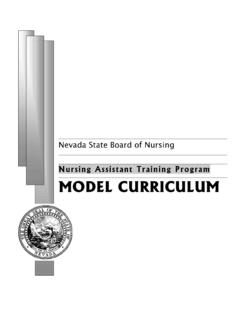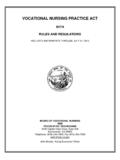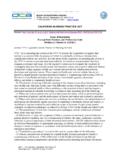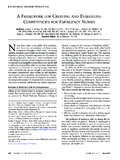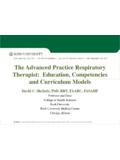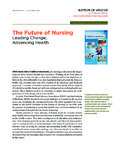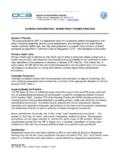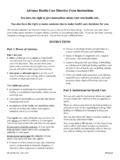Transcription of Nevada State Board of Nursing
1 Nevada State Board OF Nursing Practice Decision The Role of the RN in Conscious Sedation It is within the scope of practice of the RN to manage the care of patients receiving IV conscious sedation during therapeutic, diagnostic, or surgical procedures provided the following criteria are met: 1. A qualified anesthesia provider or practitioner selects and orders the medications to achieve minimal or moderate sedation. 2. Guidelines for patient monitoring, drug administration and protocols for dealing with potential complications or emergency situations are available and have been developed in accordance with accepted standards of practice.
2 3. The RN managing the care of the patient receiving minimal or moderate sedation shall have no other responsibilities that would leave the patient unattended or compromise continuous monitoring. 4. The RN has completed ACLS and PALS (for the pediatric patient) 5. The RN has demonstrated current competencies regarding the administration and monitoring of minimal and moderate sedation. COMPETENCIES The registered nurse must be competent to perform the function, and the function must be performed in a manner consistent with the standard of practice. In administering medications to induce procedural sedation, the RN is required to have the same knowledge and skills as for any other medication the nurse administers.
3 This knowledge base includes but is not limited to: effects of the medication, potential side effects of the medication, contraindications for the administration of the medication, and the amount of the medication to be administered. The requisite skills include the ability to: competently and safely administer the medication by the specified route, anticipate and recognize the potential complications of the medication, recognize emergency situations, and institute emergency procedures. Thus the RN shall be held accountable for knowledge of the medication and for ensuring that the proper safety measures are followed.
4 The institution shall have in place a process for evaluating and documenting the RN s demonstration of the knowledge, skills and abilities for the management of patients receiving agents to render procedural sedation. Evaluation and documentation of competency shall occur on an annual basis. SAFETY CONSIDERATIONS The safety considerations for conscious sedation include: continuous monitoring of oxygen saturation, cardiac rate and rhythm, blood pressure, respiratory rate and level of consciousness. The RN shall ensure the immediate, on-site availability of back-up personnel for airway management, resuscitative and emergency intubation and of emergency equipment which contains resuscitative and antagonistic medications, airway and ventilatory adjunct equipment, defibrillator, suction and a source for administration of 100% oxygen.
5 The RN administering agents to render conscious sedation shall conduct a Nursing assessment to determine that administration of the drug is in the patient s best interest. The RN shall ensure that all safety measures are in force. MANAGEMENT OF Nursing CARE The RN is held accountable for any act of Nursing provided to a patient. The RN managing the care of the patient receiving conscious sedation shall not leave the patient unattended or engage in tasks that would compromise continuous monitoring of the patient by the registered nurse. The complex Nursing functions, including vital signs, shall not be assigned to unlicensed assistive personnel.
6 The RN has the right and obligation to act as the patient s advocate by refusing to administer or continue to administer any medication not in the patient s best interest. DEFINITIONS OF CONSCIOUS SEDATION Minimal sedation: A drug-induced State during which patients respond normally to verbal commands. Although cognitive function and coordination may be impaired, ventilator and cardiovascular function are unaffected (AACN and ASA). Moderate sedation: A drug-induced depression of consciousness during which patients respond purposefully to verbal commands either alone or accompanied by tactile stimulation.
7 No interventions are required to maintain a patent airway, and spontaneous ventilation is adequate. Protective airway reflexes and cardiovascular function are usually maintained (ASA). Procedural sedation: A technique of administering sedatives or dissociative agents with or without analgesics to induce a State that allows the patient to tolerate unpleasant procedures while maintaining cardio respiratory functions (ACEP). RESOURCES Conscious Sedation, California Nurse Practice Act, NPR-B-06 AORN Recommended practices for Monitoring the Patient Receiving Intravenous Sedation, Association of Operating Room Nurses, Inc.
8 Position Statement on the Role of the Registered Nurse in the Management of Patients Receiving IV Conscious Sedation for Short-Term Therapeutic, Diagnostic, or Surgical Procedures, American Nurses Association Qualified Providers of Conscious Sedation, American Association of Nurse Anesthetists ISMP Medication Safety Alert! Acute Care, Institute for Safe Medication practices . November 3, 2005. Volume 10, Issue 22. Sedation Levels & Definitions adopted by the American Society of Anesthesiologists (ASA, October 2007) American Association of Critical-Care Nurses(AACN) Position Statement, AACN Sedation Guidelines, March 2002.
9 Approved by the Nevada State Board of Nursing : 3/16/05 (Replaced Anesthetic Agents Decision) Approved by the NSBN s Nurse Practice Advisory Committee: 12/5/06 Approved by the Nevada State Board of Nursing : 1/24/07 Reviewed by the Nurse Practice Advisory Committee, 04/12/11 and 06/14/11 Approved by the Nevada State Board of Nursing : September 14, 2011







